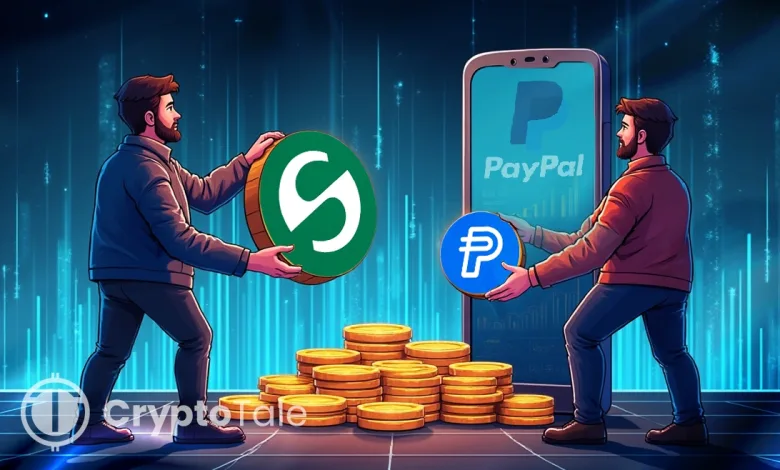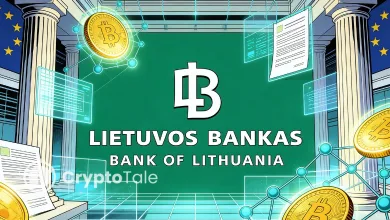Stable Integrates PayPal’s PYUSD to Boost Global Payments

- Stable integrates PayPal’s PYUSD to drive instant, gas-free stablecoin payments worldwide.
- The partnership pressures USDT and USDC by expanding PYUSD into cross-chain commerce.
- Analysts see the move as a step toward stablecoins powering real-world payments at scale.
Stable, a blockchain backed by Bitfinex and closely tied to Tether, has integrated PayPal’s PYUSD stablecoin with backing from PayPal Ventures. PayPal Ventures announced its strategic investment on Monday, aligning Stable’s “gas-less” transaction model with PayPal’s goal of scaling digital dollar payments worldwide. The partnership positions PYUSD alongside USDT as a core asset within Stable’s ecosystem, designed for seamless, fast, and low-cost transfers.
Stable’s Design and New Integration
Stable launched in July after raising $28 million in seed funding from Bitfinex and Hack VC. Its network was designed for real-dollar settlement, using USDT as its native gas token and promoting sub-second, gas-free peer transfers.
The integration of PYUSD extends Stable’s model beyond USDT and introduces PayPal’s dollar-backed token into infrastructure built specifically for stablecoin commerce. According to PayPal’s David Weber, the collaboration will expand PYUSD’s utility across multiple blockchain ecosystems while driving adoption for new payment flows.
Stable’s system focuses on instant, gas-free remittances and cross-border commerce, which remain costly or inefficient under existing infrastructure. Its architecture eliminates the need for volatile tokens to move digital dollars, which makes it easier to use by mainstream users and businesses alike.
Implications for the Stablecoin Market
The deal is an indication of an increase in competition among stablecoin providers. Tether’s USDT is the market leader with a capitalization of over $170 billion, while the USDC by Circle remains the primary competitor. PayPal’s PYUSD, launched in 2023 with Paxos, has grown to a $1.4 billion valuation, ranking eleventh among stablecoins.
Analysts note the collaboration pushes stablecoins toward everyday utility, not just crypto-native trading. PayPal Ventures partner Amman Bhasin said Stable’s focus on emerging markets offers a unique path for scaling real-world adoption. He emphasized that reliable, dollar-based payments could have the greatest impact in regions with limited financial infrastructure.
The partnership also adds pressure to incumbents like USDT and USDC by positioning PYUSD as a commerce-focused token supported by one of the world’s largest payment brands. Industry observers see the move as part of a broader “arms race” where trusted digital dollars compete for merchant adoption and regulatory legitimacy.
Stable’s CTO Sam Kazemian highlighted the alignment with PayPal’s decades-long expertise in delivering intuitive, global payment systems. He said the integration builds the foundation for new use cases in cross-border payments, retail commerce, and financial products.
Related: PayPal Expands PYUSD0 Across Chains in $2T Stablecoin Push
With PYUSD now live on Stablechain, the integration marks a new phase in stablecoin evolution: infrastructure built for payments at scale. Both companies stress that the collaboration could unlock entirely new commerce-related use cases, supported by gas-free transfers and instant settlement.
The development also brings regulatory considerations into focus. As PayPal works within a high compliance policy, the joint venture may test regulators’ perception of stablecoins with the support of already established financial organizations. The presence of USDT and PYUSD on one chain raises questions on interoperability, liquidity management and trust.
For PayPal, the integration expands PYUSD’s reach across multiple ecosystems. For Stable, it is reinforces the vision of the project to establish a hub for the stablecoin-powered commerce. Together, the companies are expected to make stablecoins from trading instruments into digital dollars integrated into worldwide financial systems.
Industry leaders suggest this step underscores the shift from speculation to utility. Stablecoins are evolving from crypto-native markets into infrastructure for instant, reliable payments that rival existing rails.




